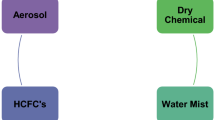Abstract
A variety of private and public sector programs are developing a new class of fire suppressants, known generically as solid particulate aerosols. These have superior volumetric efficiency, low initial and life-cycle costs, low toxicity, no known global atmospheric environmental impacts (ODP/GWP), and the potential for a wide variety of applications. Researchers are developing solid compound formulations that, when pyrotechnically initiated, generate powerful fire suppressant aerosols that behave more lightly than do air gases. Preliminary indications show that these aerosols are up to four times more powerful as fire suppressants on a mass basis than Halon 1301. Using a solid, gel, or powder as the starting point for generating an aerosol eliminates the need for piping and pressure cylinders and creates a potential for a wide variety of fire suppression applications in facilities, aircraft cargo containers, portable rapid deployment shelters, fuel storage tanks, battery/UPS rooms, unstaffed telecommunications facilities, and armored vehicle engine compartments. The speed of aerosol formation depends upon system design and configuration. This paper covers mechanisms of aerosol fire suppression and presents the most recent test results.
Similar content being viewed by others
References
Spurny, K. R., “Physical Characterization of Single Particles and of Particle Collectives,”Physical Characterization of Individual Airborne Particles, K. R. Spurny, ed., Ellis Horwood, Ltd., Chichester, U.K. (1986), pp. 31–34.
Billings, C. E., and Gussman, R. A., “Dynamic Behavior of Aerosols,”Handbook on Aerosols, R. Dennis, ed., NTIS (1976), pp. 40–65.
Birchall, J. D., “On the Mechanism of Flame Inhibition by Alkali Metal Salts,”Combustion and Flame Volume 14 (1970), pp. 85–96.
Rosser, W. A., Inami, S. H., and Wise, H., “The Effect of Metal Salts on Premixed Hydrocarbon-Air Flames,”Combustion and Flame Volume 7 (1963), pp. 107–119.
Ewing, C. T., Faith, F. R., Hughes, J. T. and Carhart, H. W., “Evidence for Flame Extinguishment by Thermal Mechanisms,”Fire Technology Volume 25 (1989), pp. 195–212.
Ewing, C. T., Faith, F. R., Hughes, J. T., and Carhart, H. W. “Flame Extinguishment Properties of Dry Chemicals: Extinction Concentrations for Small Pan Fires,”Fire Technology Volume 25 (1989), pp. 134–149.
Ewing, C. T., Faith, F. R., Romans, J. B., Hughes, J. T., and Carhart, H. W. “Flame Extinguishment Properties of Dry Chemicals: Extinction Weights for Small Diffusion Pan Fires and Additional Evidence for Flame Extinguishment by Thermal Mechanisms,”Journal of Fire Protection Engineering Vol. 4 (1992), pp. 35–42.
Ewing, C. T., Hughes, J. T., and Carhart, H. W., “The Extinction of Hydrocarbon Flames Based on Heat-Absorption Processes Which Occur in Them,”Fire and Materials Volume 8 (1984), p. 149.
Smith, E. A., Kimmel, E. C., Bowen, L. E., Reboulet, J. E., and Carpenter, R. L., “The Toxicological Assessment of a Fire Suppressant and Potential Substitute for Ozone-Depleting Substances,” unpublished manuscript, March 1994, Navy Medical Research Institute Detachment (Toxicology), Building 433, Area B, Wright-Patterson Air Force Base, Ohio 45433-7903 U.S.A.
Andreev, V. A., Kopylov, N. P., Makeev, V. I., Merkulov, V. A., and Nikolaev, V. N., “Replacement of Halon in Fire Extinguishing Systems,”Proceedings of the 1993 Halon Alternatives Technical Working Conference, Albuquerque, New Mexico, May 1993.
Zhang, G., Informal communication from Ansul Fire Protection, McLean, Virginia, March 1994.
Sheinson, R.S.,et al., “Fire Extinguishment by Fine Aerosol Generation,”Proceedings of the CFC & Halon Alternatives Conference, Washington, D.C., October 1993.
Author information
Authors and Affiliations
Rights and permissions
About this article
Cite this article
Kibert, C.J., Dierdorf, D. Solid particulate aerosol fire suppressants. Fire Technol 30, 387–399 (1994). https://doi.org/10.1007/BF01039940
Issue Date:
DOI: https://doi.org/10.1007/BF01039940




